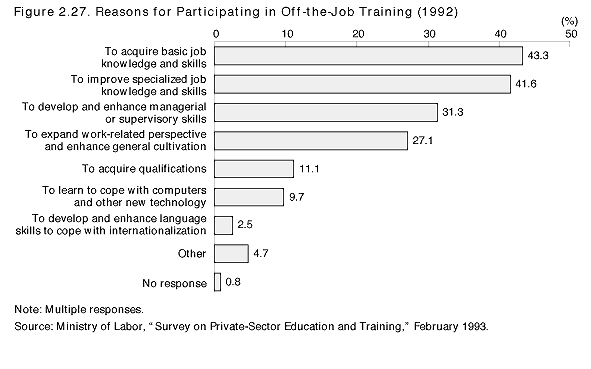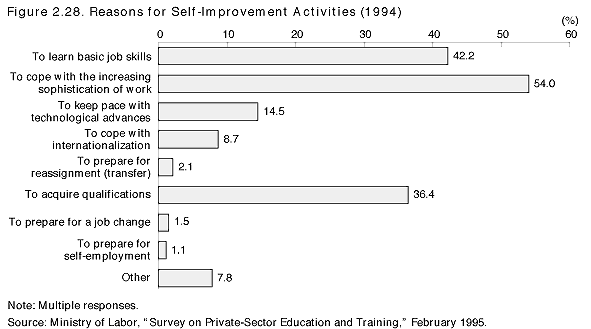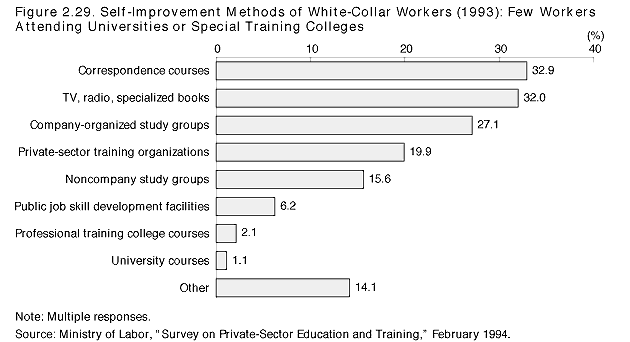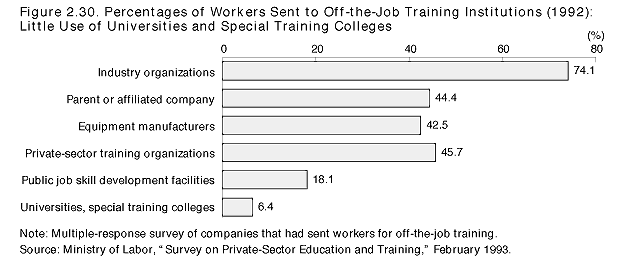| Home > Policy > White Paper, Notice, Announcement > White Paper > JAPANESE GOVERNMENT POLICIES IN EDUCATION, SCIENCE, SPORTS AND CULTURE 1996 > Priorities and Prospects for a Lifelong Learning Society Chapter 2 Section 1 9 | ||
As discussed in subsection 2, surveys on lifelong learning include such areas as hobbies, general cultivation, and sports, but they do not always cover work-related learning activities. The 1995 Ministry of Labor "Survey on Private-Sector Education and Training," however, indicates that 50.9% of workers underwent off-the-job training *1 and that 57.0% undertook self-improvement activities *2 in 1994 ( Figure 2.26 ). The 1993 survey shows that 43.3% of respondents undertook off-the-job training "to acquire basic job knowledge and skills," 41.6% "to improve specialized job knowledge and skills," and 31.3% "to develop and enhance managerial or supervisory skills" in 1992 ( Figure 2.27 ). The 1995 survey indicates that 54.0% of those undertaking self-improvement activities in 1994 did so "to cope with the increasing sophistication of work," 42.2% to "to learn basic job skills," and 36.4% "to acquire qualifications" ( Figure 2.28 ).
A significant number of people are involved in work-related learning activities, but tend not to recognize these activities as part of lifelong learning. Moreover, there is still a gap between the percentage of workers interested in skill development (91.1% in 1993) and self-improvement (90.5% in 1992) and the percentage actually engaged in such activities.
*1 Off-the-job training: This is a form of job training that involves temporary absence from the workplace.
*2 Self-improvement activities: These are voluntary activities undertaken in order to improve job skills.
The 1994 Ministry of Labor survey shows that while around 30% of white-collar workers cited "correspondence courses" and "TV, radio, specialized books" as self-improvement methods in 1993, "professional training college courses" and "university courses" were cited by only 2.1% and 1.1%, respectively ( Figure 2.29 ). Moreover, the 1991 survey indicates that approximately 40% of workers in general who undertook self-improvement activities in 1990 participated in study groups, courses, and seminars outside their companies, whereas only 2.9% attended special training colleges and just 0.8% took university courses. And the 1993 survey shows that of companies that sent employees for off-the-job training in 1992, 74.1% used training programs provided by industry organizations and 45.7% chose other private-sector providers. Only 6.4% of companies sent employees to universities and special training colleges ( Figure 2.30 ).





| Back to Top | MEXT HOME |